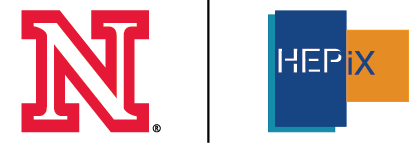Dr
Dimitri Bourilkov
(University of Florida (US))
15/10/2014, 14:30
Storage & Filesystems
Design, performance, scalability, operational experience, monitoring,
different modes of access and expansion plans for the Lustre
filesystems, deployed for high performance computing at the University
of Florida, are described. Currently we are running storage systems of
1.7 petabytes for the CMS Tier2 center and 2.0 petabytes for the
university-wide HPC center.
Luca Mascetti
(CERN)
15/10/2014, 15:00
Storage & Filesystems
In this contribution we report our experience in operating EOS, the CERN-IT high-performance disk-only solution, in multiple Computer Centres. EOS is one of the first production services exploiting the CERN's new facility located in Budapest, using his stochastic geo-location of data replicas.
Currently EOS holds more than 100PB of raw disk space for the four big experiments (ALICE, ATLAS,...
Jeffrey Dost
(UCSD)
15/10/2014, 16:00
Storage & Filesystems
We have developed an XRootD extension to Hadoop at UCSD that allows a site to significantly free local storage space by taking advantage of the file redundancy already provided by the XRootD Federation. Rather than failing when a corrupt portion of a file is accessed, the hdfs-xrootd-fallback system retrieves the segment from another site using XRootD, thus serving the original file to the end...
Luca Mascetti
(CERN)
15/10/2014, 16:30
Storage & Filesystems
Cernbox is a cloud synchronization service for end-users: it allows to sync and share files on all major platforms (Linux, Windows, MacOSX, Android, iOS). The very successful beta phase of the service demonstrated high demand in the community for such easily accessible cloud storage solution. Integration of Cernbox service with the EOS storage backend is the next step towards providing sync...
Brian Behlendorf
(LLNL)
16/10/2014, 09:00
Storage & Filesystems
OpenZFS is a storage platform that encompasses the functionality of a traditional filesystem and volume manager. It's highly scalable, provides robust data protection, supports advanced features like snapshots and clones, and is easy to administer. These features make it an appealing choice for HPC sites like LLNL which uses it for all production Lustre filesystems.
This contribution...
Liviu Valsan
(CERN)
16/10/2014, 09:30
Storage & Filesystems
Flash storage is slowly becoming more and more prevalent in the High Energy Physics community. When deploying Solid State Drives (SSDs) it's important to understand their capabilities and limitations, allowing to choose the best adapted product for the use case at hand. Benchmarking results from synthetic and real-world workloads on a wide array of Solid State Drives will be presented. The new...
Mr
Alexandr Zaytsev
(Brookhaven National Laboratory (US))
16/10/2014, 10:00
Storage & Filesystems
Ceph based storage solutions are becoming increasingly popular within the HEP/NP community over the last few years. With the current status of Ceph project, both object storage and block storage layers are production ready on a large scale, and the Ceph file system storage layer (CephFS) is rapidly getting to that state as well. This contribution contains a thorough review of various...
Andrea Manzi
(CERN)
16/10/2014, 11:00
Storage & Filesystems
In this contribution we give a set of hints for the performance tuning of the upcoming DPM releases, and we show what one can achieve by looking at different graphs taken from the DPM nightly performance tests.
Our focus is on the HTTP/WebDAV and Xrootd protocols and the newer "dmlite" software framework, and some of these hints may give some benefit also to older, legacy protocol...
Ruben Domingo Gaspar Aparicio
(CERN)
16/10/2014, 11:20
Storage & Filesystems
CERN IT-DB group is migrating its storage platform, mainly NetApp NAS’s running on 7-mode but also SAN arrays, to a set of NetApp C-mode clusters. The largest one is made of 14 controllers and it will hold a range of critical databases from administration to accelerators control or experiment control databases. This talk shows our setup: network, monitoring, use of features like transparent...
Tony Quan
(LBL)
16/10/2014, 11:40
Storage & Filesystems
The PDSF Cluster at NERSC has been providing a data-intensive computing resource for experimental high energy particle and nuclear physics experiments (currently Alice, ATLAS, STAR, ICECUBE, MAJORANA) since 1996. Storage is implemented as a GPFS cluster built out of a variety of commodity hardware (Dell, Raidinc, Supermicro storage and servers). Recently we increased its capacity by 500TB by...
